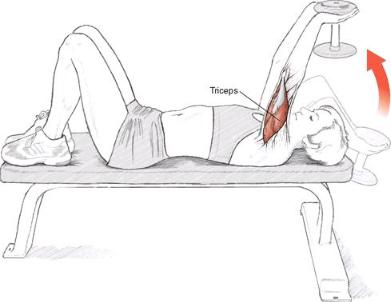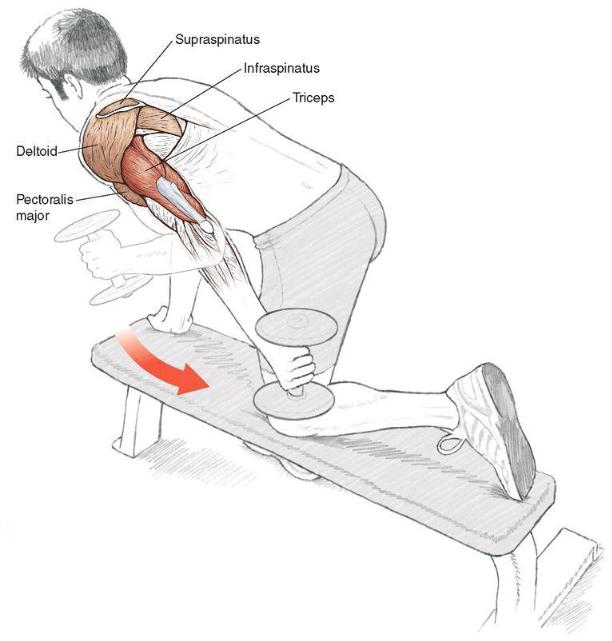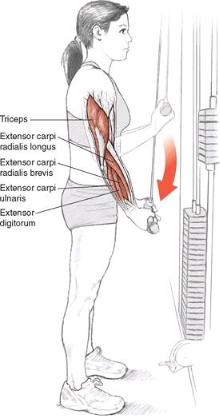
Анатомия бега (2010,иностр
.).pdf
Execution
1.Lie on a flat bench with both feet on the bench. The torso should be stable. Arms are bent 90 degrees at the elbow, shoulder-width apart. Hold a dumbbell of an appropriate weight with both hands, palms inward.
2.Extend the forearms to full extension.
3.Lower the arms to the initial position slowly, resisting the weight.

Muscles Involved
Primary: triceps
SAFETY TIP Have a spotter place the weight in your hands and hold the weight in place until you begin the exercise. If there is not a spotter, begin the exercise with the arms in the extended position, and perform the negative (lowering the weight) action as the first movement.

Running Focus
The introduction to this chapter emphasized the importance of the arms in balancing and counterbalancing during running. The triceps exercises listed in this section serve to balance the recommended biceps exercises, creating a well-developed and strengthened upper arm. The muscles of the forearm are involved as secondary movers. The only movement occurs at the elbow joint, precipitated by the engagement of the triceps.
VARIATION
Barbell Lying Triceps Extension
Instead of using a dumbbell, using a barbell to perform the same exercise works well. Execute the exercise the same way, and follow the same safety instructions.
Single-Arm Dumbbell Kickback With Bench

Execution
1.Kneel on a flat bench with one leg. Keep the spine and torso in a straight line with your head. Establish a stable base of support with the non-weight-bearing hand pressed to the bench, and the opposite-side leg extended with the foot on the floor. The weight-bearing arm is bent at about a 90-degree angle with the palm inward.
2.Extend the forearm backward from the elbow, using the triceps muscles to instigate the movement in a slow, fluid fashion. Keep the elbow in a fixed position parallel to the torso, not higher. Exhale during this motion.
3.Upon straightening the arm, allow the weight to return the arm to 90 degrees by providing gentle resistance. Inhale during the return.
Muscles Involved
Primary: triceps
Secondary: infraspinatus, supraspinatus, deltoid, pectoralis major
TECHNIQUE TIP
It is important not to vary elbow position during the exercise. Keep the elbow tight to the body and fixed. Try to avoid dropping the shoulder to help push the weight backward.

Running Focus
The dumbbell kickback is primarily a triceps exercise, but it recruits the infraspinatus and the supraspinatus muscles of the shoulder. Because the initiation of the arm swing during running takes place in the shoulder, strengthening the triceps and shoulder via this exercise helps ward off arm fatigue and bad posture, two energy-sapping scourges of good performance.
VARIATION
Double-Arm Dumbbell Kickback
The double-arm variation does not require a bench. From a standing position, bend over at the waist so your torso is close to parallel to the floor, feet shoulder-width apart, and grasp a dumbbell in each hand with the arms hanging downward. Perform the kickback movement with both arms simultaneously. The exercise uses the same muscles as the single-arm kickback using a bench, and will incorporate the core muscles of the abdomen and lower back to stabilize the body.

Machine Reverse Push-Down
Execution
1.Standing with your feet narrower than shoulder-width apart, grasp the short, straight bar attached to a cable (on a pulley attached to the machine) with palms upward (underhand grip). The forearms are extended at approximately 75 degrees to the elbows, which remain fixed at your sides throughout the exercise.
2.In a smooth, uninterrupted motion, push the forearms downward in full extension, keeping the elbows fixed in their original position and close to the body. Exhale throughout the motion.
3.Allow the weight to return to the original position by resisting the pull of the cable gradually and in a smooth manner. Inhale during this part of the exercise.
